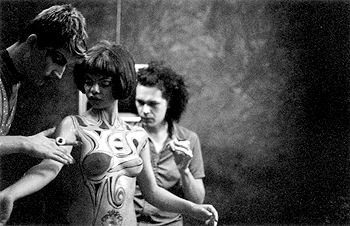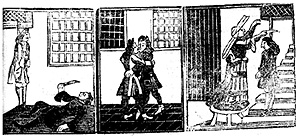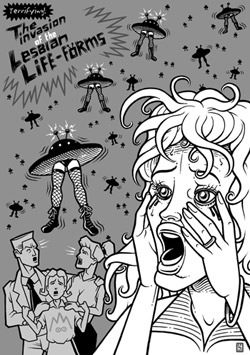LESBO 11/12
Id. 2001: SCENE
Back
to English sites
Vrni v seznam vsebine LESBO 11/12
-
SUMMARY 11/12
Lesbo is a Slovene political, social and cultural non-profit
making quarterly. Its founder and publisher is the lesbian group
ŠKUC-LL. The editress-in-chief is Nataša Velikonja, the design
editress is Barbara Predan.
Lesbo magazine aims at sharpening the critical and intellectual
blades. It promotes politics, stories and views, arts and attitudes,
practices and theories about the resistance and radical fights
against homophobia and any other exclusive orientations. As such
it participates in wider civil, political, social and cultural
efforts aiming at breaking the massive walls of civil apathy,
political ignorance, ideological terror and mind exploitation.

Body Painting Playboy Girl
The 11th-12th issue of Lesbo magazine is titled “The Scenes”,
because the centre of its discussion is analytical viewing of
different levels of significant physical or symbolic points and
places, which are marked as gay or lesbian, transgender or transsexual,
in political and geographical aspect, in social or just sociable
life in Slovenia. The emphasises are given to the gay & lesbian
club infrastructure and dynamics, to the platforms, which generally
frame the way of gay and lesbian visibility within the public
sphere. But one of also relevant, but nevertheless often veiled
moment of visibility of homosexuality or the relation to it comes
from other “scenes”, too - from political, media, etc. How are
gays and lesbians marked in Slovene politics, jurisdiction, how
are they treated in working sphere etc.?
In the editorial, Nataša Sukič writes about some segments of
gay and lesbian club life in Ljubljana. Her starting-point is
the introduction of members' club-cards in Roza disco in the season
of 1992/1993, which, in her opinion, essentially restricted ranges
of gay and lesbian club culture, which were successfully gained
in “the legendary K4” in previous seasons. She claims, that the
club K4, Roza disco on Sundays - which till then had a strong
public and media support because of the linking and mutual tolerance
of various identities - due to that kind of “politics at the doors”,
the politics of cultural program; it became extremely limited,
but at the same time it ghettoised the gay & lesbian scene
even more. She connects all of this with the simultaneous turn
of the state and social atmosphere in the nineties to the provinciality
and traditionalism, which make the breakthru of gay and lesbian
visibility even harder. She asks, if gays and lesbians are, on
the level of club culture in Ljubljana, in the open gay &
lesbian clubs, such are Tiffany, Monocle or K4, still capable
of rebellion or subversion with the help of satire and parody.

From the rubric “Porno-vision”
She develops these main theses further in her article “Destruction
of the club culture”, which is a part of “The Rubric”, specially
centred - together with “Porno-vision” - to the gay and lesbian
scenes in Ljubljana. Analyses of gay and lesbian club scenes in
Ljubljana are continued with the commentaries, written by Urška
Sterle and Nataša Koražija. Urška Sterle, in her article “Apathy”,
writes about Slovene LGBT scene, which - if we speak about its
extent - has already overgrown its available places. A higher
number of consumers in the scene has not brought a plurality of
styles alone with it. On the contrary, the apathy, the rejection
of being political subjects in general and the withdrawal into
privacy, melting of styles and the uniformity constitute the dominant
value consensus on it. In the “Big Banquet” Nataša Koražija focuses
the view on the scene on the lesbian club Monocle. Since Nataša
Sukič wrote some years ago, that 20 m2 of the lesbian territory
- the size of Monocle, lesbian club in Metelkova Squat - means
a revolution to her, Koražija adds, that this “revolution” is,
after three years, still going on and has since expanded to 25
m2. The revolution is, she claims, that the lesbian club - in
the surrounding area of the likeable gay neo-baroque of gay club
Tiffany, waves of new primitivism, macho-football attitudes, imperialism
of the city politics and frequent police parades - lives on. Metelkova
squat is a place of most subtle urban subcultures, so let's cultivate
a multi-domicile stance, let more and more people support durable
ties to it!
The rubric “Porno-vision” - usually dealing with the sexual politics
and theories - is, in this issue, also directed toward mapping
and analysing gay and lesbian scenes and subcultures - but in
a worldly context. Roman Kuhar, in his study “Episodes from the
gay/lesbian history: The Subculture Is Born”, traces the birth
of gay & lesbian subcultures in the beginning of the 18th
Century, when the police and moral institutions first started
to report about them. Especially with police reports, police harassment,
convictions of sodomites and their scenes and popular press, the
consciousness of the existence of sodomite subcultures started
to raise. Kuhar touches several cases: from London, Paris and
Amsterdam.

“10 years are enough”, Illustration by Boris Benko
The monitoring of state policy and general politics is a strong
part of Lesbo magazine: in the section titled “Llobby”, Nikolai
Jeffs, in his essay “10 years are enough”, analyses in details
the tenth anniversary of the independence of the Republic of Slovenia.
Its foundations - human rights and democracy - seem like, he states,
a building-platform, which enabled the dominant elite and their
priests to grab at the power; and when the façade was done, the
ladder was knocked down for all the rest. Jeffs claims that the
manipulation of the same-sex orientated women and men is already
paradigmatic. That is to say, in 1990 all the political parties
in Slovenia signed the statement “The Right To Be Different”,
which could have been the very first step towards the end of discrimination
and to the full acceptance of the homosexual population in Slovene
society. But all obligations were already forgotten in the next
year. In 1991, in the new Constitution, the article, which would
assure the equality regardless of sexual orientation, was not
added, and the “right to be different” became more and more redundant.
Ten years are enough, he concludes, enough of this “success story”
[electoral slogan of the ruling party, Liberal Democracy of Slovenia],
where the restrictive jurisdiction concerning public meetings
is developing, which limits the notion of politics as a protest,
as a solidarity with the prosecuted and as a sociability with
the free-minded; where the media sphere is restricted more and
more; where police harassment to asylum seekers, to free-thinkers,
to gays and lesbians occurs fact on a daily basis; where public-pool
research shows extremely high rates of intolerance, even racism
and fascism; where the human rights are put on the referendum
and so on. But, the rebellion is continuing, since there are people,
who treat human rights, democracy and creativity as a serious
and unfinished project.

“I Protest!”, Illustration by Boris Benko
The section “Llobby” is continued with the pamphlet “I Protest!”
by Suzana Tratnik. She speaks about the implicit, non-visible,
personal and almost banal forms of discrimination. She claims,
that the society, in which she lived as a teenage girl, robbed
her of an essential part of adolescence, that is, the chance to
research her lesbian sexuality. As she lived in a small provincial
Slovene town, lesbians or gays were not any given part of society
during her teenage years. It was not until her student years,
in the capital, Ljubljana that she was finally connected with
the lesbian lifestyle. So, she has decided - in a symbolic sense
- to sue the state of Slovenia for her damaged teenage years,
for not having researched her sexuality, for covering information
about different sexual styles from her and because she was negatively
labelled as being a sexually cold teenage girl. She values the
damage on her at 5 million Slovene Tolars (approximately 25.000
US$).
The next article, entitled “In-semination”, is written by Urška
Sterle. It's a commentary about the referendum concerning “the
law on medically assisted artificial insemination”, which also
would allow the insemination of single women. The rightwing political
scene and the right orientated part of public opinion claim that
the children can be “appropriately” raised only within the parental
unit, consisting of a father and a mother. The result of that
pressure was the referendum. The liberal part found in that kind
of social statement discriminatory measure and the strategy which
could lead to the slowly passing of non-equal treatment of citizens
and to the lowering the equality status of women's rights. In
the debate around the referendum, special emphasis was put to
lesbian and handicapped women - generally within insulting, totally
homophobic and fascist tones (some of them, from the media and
political sphere, are printed in the “Media” rubric). 30 % of
the population participated in the referendum and the great (app.
75 %) majority voted “against” the right of a single woman to
have the access to artificial insemination.

Hans Ytteberg
This issue brings interviews with two state servants: with the
ombudsman for human rights in Slovenia, Matjaž Hanžek, and with
the Swedish ombudsman for gays and lesbians, Hans Ytteberg. Both
interviews were conducted by Tatjana Greif.
The Foreign policy's part is concluded by Tom Thomson's essay
“Gay and Lesbian Movement Goes To the Shopping Mall”. It is a
discussion about the possibility of the anarchis-tic alternative
to the political cooptation of the queer struggle. Thomson criticises
the accommodation of gay & lesbian human right movement, its
turn to integrationist and assimilation policy, its strong connection
with consumer power, and, at the same time, its disconnection
with other civil society movements, such as the struggle against
the capitalist, corporate political economy, social hierarchy,
systems of control and repression or state power. He claims, that
the kind of non-confrontational activism, which is practised by
the mainstream GL activism, is not efficient on the level of jurisdiction,
school systems, etc. i.e., in all institutions of state power.
One of this issue's central topics are the results of the study
“Discri-mination on the level of sexual orientation”. The entire
study, which was conducted by ILGA-Europe (Tatjana Greif for Slovenia),
is translated and published in the continuation of the magazine.
The section “The School” brings the second part of Andrej Zornik's
feuilleton, “Homosexuality and the School”, a study which covers
the treatment of homosexuality in Slovene primary and secondary
schools. Special emphasise is given to the “Letter Against Homophobia”,
which The Association for the non-violent communication (for it
Klavdija Aničić) and 13 organisations, addressed in this spring
to the public and to the state Ministry for Education, Science
and Sport. This was an attempt of civil society to encourage these
institutions to de-mystify speaking about homosexuality in the
schools. For several years The Association for non-violent communication
performed a set of work-shops about violence, discrimination and
solving problems in secondary schools. A part of the program was
the work-shop on homosexuality, but this year the High School
for print and paper in Ljubljana rejected it because of complaints
from the parents.

Metka Krašovec
The rubric “Out of the Closet” brings forth the cultural part
of Lesbo magazine. It points to those public events in the Slovene
gay & lesbian scene, which succeeded in breaking the high
walls of public homophobia or successfully include anti-homophobic
struggle in a wider social platform. Their common characteristic
is their successful access to crossing-over communities, breaking
out of the gay and lesbian ghetto, but - of course - without veiling
the homosexual context. In previous months of 2001 those were
The Bureau of Intervention, a coordination of individuals and
social groups; Lesbian Library, which opened its doors on the
1st of May this year in Ljubljana; the graffiti action - group
Act on the Wall; and Ljubljana's transvestite scene, with its
strong public influence and recognition.
The section “Culture” is composed of three articles and some previews
commenting on several aspects of cultural life concerning lesbian
and gay topics. Under the title “Sex and Culture” Nataša Velikonja
describes, how identity - also sexual - is articulated as a cultural
phenomenon; how sexuality is organized through logic of cultural
identification. It, therefore, belongs to the field of cultural
or social studies: what feminist studies do to the category of
“gender”, gay & lesbian studies do to the category of “sexuality”.
Velikonja states that cultural identification is an important
element of constructing sexual identity. She gives two examples,
which show the possible impacts of artistic works on the construction
of lesbian, homosexual, identity. The analysis covers the mirror-images
on the paintings of Slovene artist Metka Krašovec, which are compared
with the mirror-image paintings of British painter Sadie Lee.
Mirror images of women are often used as a code for lesbian sexuality;
despite the frequency of this motif in the history of art, Slovene
art critics insist on the interpretation of mirror-images of Krašovec
as the play of Narcissi. It is quite bizarre that their interpretation
is so very uniform and one-dimensioned, without even a hint of
openness to other possibilities. The second case touches some
songs and lyrics, written by American singer and poet Patti Smith,
which are coloured with the lesbian erotica. Not only with her
art, but also with her gestures and images, Smith - herself straight
- was one of strong identification models for lesbians. Patti
Smith, especially lesbian motifs in her poetry, is presented -
at the occasion of her first, July's concert in Ljubljana - in
the rubric “The Portrait”.
Non-conformity in the art world, connected with the meanings
around (homo)sexuality, is also the topic of the next two articles:
Andreja Gomišček in the short pamphlet “Galleries in the Open
Air” writes about the art, which must be accessible, vivid and
free - as an exhibit on open city platforms, for example, not
in the limited and dead galleries. She states, that such “free
galleries” could be good for gay & lesbian art too, for its
visibility, because it comprises the sense of human diversity
and choice. Mavis Bayton's “Lesbians” speaks about queer core
movement and music, especially in Britain. The Culture part of
Lesbo is concluded with some book and musical reviews.
This issue brings a lot of short political and cultural news.
It is also rich in photo and graphic material, (done by Srečo
B. - Daphne, Urška Merc, etc.) giving some visual information
about Ljubljana's gay and lesbian scenes. Satiric visualities
and comics, made by Boris Benko, excite special curiosity and
attention.
Translation: NV, EŽ
Back to English sites
Vrni v seznam vsebine LESBO
11/12
Uvodnik | LLOBBY
- notranji | Tema
trimesečja | LLOBBY
- zunanji |
ŠOLA | KULTURA
| KLOZET |
MEDIA | PORTRET
| SCENA
| PORNOVIZIJA
| SUMMARY
Za pregled vsebine posamezne številke, spodaj izberi naslovnico.
NAZAJ NA NOVICE
|

